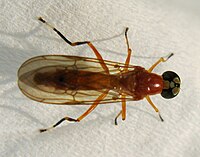
The Phoridae are a family of small, hump-backed flies resembling fruit flies. Phorid flies can often be identified by their escape habit of running rapidly across a surface rather than taking to the wing. This behaviour is a source of one of their alternate names, scuttle fly. Another vernacular name, coffin fly, refers to Conicera tibialis. About 4,000 species are known in 230 genera. The most well-known species is cosmopolitan Megaselia scalaris. At 0.4 mm in length, the world's smallest fly is the phorid Euryplatea nanaknihali.

The Fanniidae are a small group of true flies largely confined to the Holarctic and temperate Neotropical realms; there are 11 Afrotropical species, 29 Oriental, and 14 Australasian.

Hermetia illucens, the black soldier fly, is a common and widespread fly of the family Stratiomyidae. Since the late 20th century, H. illucens has increasingly been gaining attention because of its usefulness for recycling organic waste and generating animal feed.

Stratiomys chamaeleon, the clubbed general, is a European species of soldier fly.

Actina chalybea is a species of 'soldier flies' belonging to the family Stratiomyidae subfamily Beridinae.

Chloromyia formosa is a species of soldier flies belonging to the family Stratiomyidae. Another name for it is Broad centurion.

Stratiomys is a genus of flies in the family Stratiomyidae.

Stratiomyini is a tribe of flies in the family Stratiomyidae.

Zabrachia is a genus of soldier flies in the family Stratiomyidae. Adults can be distinguished from other Pachygastrinae by the fused R4 and R5 wing veins. Females have been collected during oviposition into pine wood, and larvae are known to live under the bark of coniferous trees, including lodgepole pine, ponderosa pine, and Douglas fir.

Neopachygaster is a genus of flies in the family Stratiomyidae.

Oxycera is a genus of flies in the family Stratiomyidae.
Oxycera analis, the dark-winged soldier, is a species of soldier fly.

Chorisops nagatomii, the bright four-spined legionnaire, is a European species of soldier fly.

Stratiomyinae is a subfamily of flies in the family Stratiomyidae.
Dipteran morphology differs in some significant ways from the broader morphology of insects. The Diptera is a very large and diverse order of mostly small to medium-sized insects. They have prominent compound eyes on a mobile head, and one pair of functional, membraneous wings, which are attached to a complex mesothorax. The second pair of wings, on the metathorax, are reduced to halteres. The order's fundamental peculiarity is its remarkable specialization in terms of wing shape and the morpho-anatomical adaptation of the thorax – features which lend particular agility to its flying forms. The filiform, stylate or aristate antennae correlate with the Nematocera, Brachycera and Cyclorrhapha taxa respectively. It displays substantial morphological uniformity in lower taxa, especially at the level of genus or species. The configuration of integumental bristles is of fundamental importance in their taxonomy, as is wing venation. It displays a complete metamorphosis, or holometabolous development. The larvae are legless, and have head capsules with mandibulate mouthparts in the Nematocera. The larvae of "higher flies" (Brachycera) are however headless and wormlike, and display only three instars. Pupae are obtect in the Nematocera, or coarcate in Brachycera.

Hermetia is a genus of flies of the family Stratiomyidae.

Sepedon sphegea is a Palearctic species of fly in the family Sciomyzidae, the marsh flies or snail-killing flies. The larva feeds on aquatic snails and as an opportunist on other invertebrates. The habitat of this species includes among many others, pond margins and damp meadows. It has a particular fondness for Iris pseudacorus which grow at the edges of the pond. Adults can be found all year long but the main flight period is from March to October.

Adoxomyia is a genus of soldier flies in the family Stratiomyidae.
Wohlfahrtiimonas larvae is a Gram-negative, facultatively anaerobic and motile bacterium from the genus of Wohlfahrtiimonas which has been isolated from the gut of the larva Hermetia illucens.
Oxycerina is a genus of flies in the family Stratiomyidae.


















